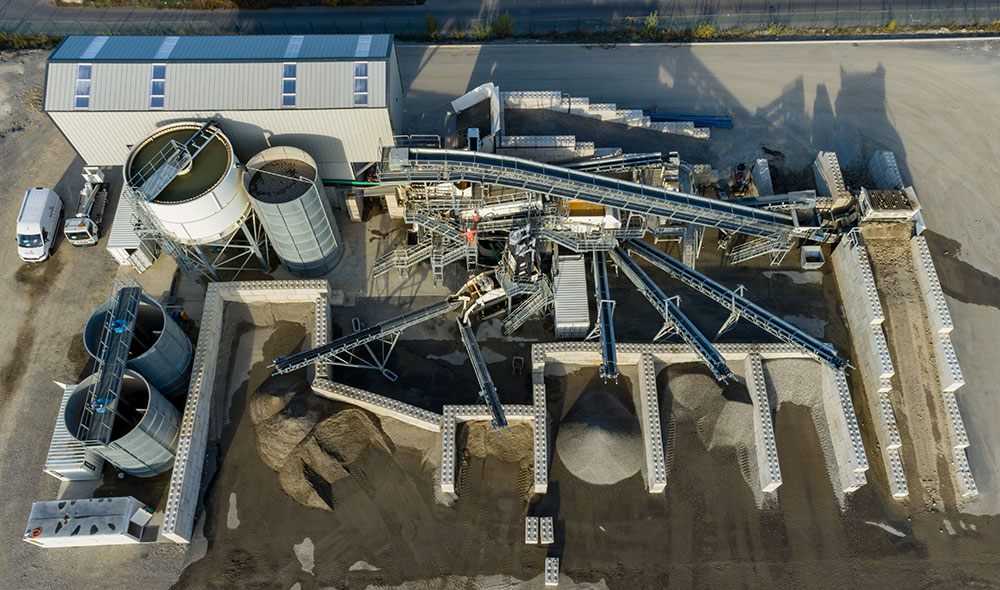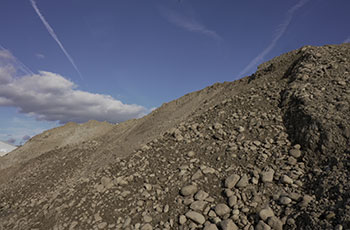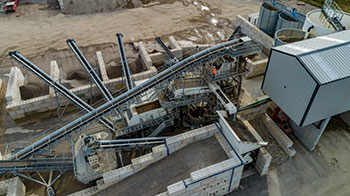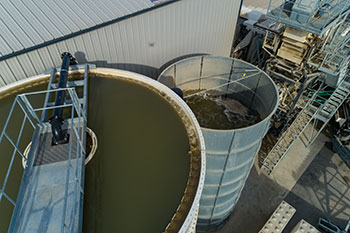Project Summary
With millions of tonnes of Construction, Demolition and Excavation waste being stockpiled each year, a system that can recycle this waste into a saleable product has environmental as well as financial benefits to aggregates producers.
This is exactly the solution SAPA, a Geneva based asphalt manufacturer, had been seeking when they began to investigate a way to recycle the waste they were sending to landfill.
Terex Washing Systems were tasked with finding a solution to this problem, which resulted in the design, manufacture and installation of a complete end to end system that could recycle construction, demolition and excavation waste. Everything from the feeder to the filterpress was included in this installation, which manages to achieve throughputs of 100 tonnes per hour.
Log Washer | Sand Plant | Deep Cone Thickener | Filter Press | Floc Dosing Unit

Featured Recycling Products
Excavation Waste Recycling
The feed material is made up of excavation waste as well as construction and demolition waste. A  H12 and H20 Feed Hopper receives loads from the shovel and removes oversized
stones (larger than 100mm) from the material, thanks to the 100mm gaps in the feeder grid. These oversized stones are stockpiled for later use. Since occasional pieces of metal were present within the feed material, an over-band magnet has been installed
after each of the feed hoppers.
H12 and H20 Feed Hopper receives loads from the shovel and removes oversized
stones (larger than 100mm) from the material, thanks to the 100mm gaps in the feeder grid. These oversized stones are stockpiled for later use. Since occasional pieces of metal were present within the feed material, an over-band magnet has been installed
after each of the feed hoppers.
The H12 Feed Hopper can be hydraulically tipped to prevent feed material from being lodged between the bars. This is controlled remotely from the cab of the shovel for safe operation.
Screening, Scrubbing and Classifying
After oversized stones and any metals are removed from the material, it makes its way up the main conveyor to be fed into a 12x5 2 Deck Rinser. This 12x5 Rinser gives the material an initial wash and classifies the material into two different sizes—with larger rocks and stones being fed towards a Terex MPS Impact Crusher and the rest making its way to an Aggrescrub 150 Log Washer . At this point, most of the sand is separated from the aggregates and is pumped towards the FM 120 C-2G Sand Plant.
The Aggrescrub 150 Log Washer uses two counter-rotating shafts fitted with a combination of AR500 blades and paddles to introduce energy into the feed material, causing the aggregates to rub and scrape together. This stone on stone attrition liberates conglomerates and breaks down the clay. The clean aggregates are then passed on to a 16x5 Horizontal 3 Deck post screen.
Once on the post screen the stone gets a final rinse to remove any residue left over from the intensive scrubbing process. The material is then separated into three different products and transferred to the relevant aggregate stockpile conveyor. From here it drops into individual bays ready to be sold. The organics and light weight trash float out the back of the hull onto the 6x2 trash screen. The organic matter, wood and plastics are dewatered into a skip ready for disposal. Any fine sand which is carried out with the wash water is recovered at this point and returned to the sand slurry sump.
The spray bars and manifold on the post screen are fixed to the chassis of the machine and are not in contact with the vibrating screen. This ensures vibrations are kept to a minimum and the lifespan of the spray bars are dramatically increased. Operators can also dynamically manage the amount of water being used in this post screen with each spray bars control valve.
Crushing Construction, Demolition and Excavation Waste
 With the smaller aggregates washed, classified and stockpiled for sale, the larger rocks and stones previously separated from the feed stock are directed towards the Terex MPS Impact Crusher. The H20 Feed
Hopper removes any oversized rocks and an over-band magnet removes any metals before they make it to the crusher. A surge bin helps to manage the flow of material to the crusher, where stones are crushed to a more desired size before being fed back
onto the main conveyor. From here another over-band magnet removes any metals that may have been dislodged during the crushing process. Stones and rocks that have been reduced to the appropriate size are then washed and classified, while oversized
material will be passed through the crusher again.
With the smaller aggregates washed, classified and stockpiled for sale, the larger rocks and stones previously separated from the feed stock are directed towards the Terex MPS Impact Crusher. The H20 Feed
Hopper removes any oversized rocks and an over-band magnet removes any metals before they make it to the crusher. A surge bin helps to manage the flow of material to the crusher, where stones are crushed to a more desired size before being fed back
onto the main conveyor. From here another over-band magnet removes any metals that may have been dislodged during the crushing process. Stones and rocks that have been reduced to the appropriate size are then washed and classified, while oversized
material will be passed through the crusher again.
Barry McMenamin, Business Line Director for Terex Washing Systems, spoke of the importance of the impact crusher within this plant, saying “With the amount of stone and rock within the feed material, the impact crusher is essential for this plant to operate efficiently. The washing elements have been designed to integrate seamlessly with this specific crusher, which is important for reducing downtime and increasing through put”.
Sand Washing
The water that has washed the aggregates up until this point in the process along with the sand is collected in the sump of the FM 120 C-2G Sand Plant. This plant consists of a collection tank, centrifugal slurry pumps, separators and a 12x5 high frequency dewatering screen. The slurry is pumped to the primary separator for an initial wash. The underflow discharges onto the dewatering screen where it receives a further rinse. Any fine sand which passes through the screen is collected in the sump and pumped to the secondary separator for a final wash. Two washes of the material at the SAPA site was necessary due to the high percentage passing 63-micron in the feed.
After this double wash process the two in spec grades of sand are dewatered on the high frequency dewatering screen, which reduces residual water content in the final product to 10-15%. The water from both separators containing the minus 63-micron material is collected in a ground sump and pumped into the deep cone thickener tank—where the water management process begins.
Aquaclear Water Management
The waste water is pumped into a deep cone thickener with flocculent added along the way, thanks  to the flocculent dosing unit present within the central control
room. Within the deep cone thickener, the waste particles of silt and clay combine to create a larger heavier particle that sinks towards the base of the cone.
The flocculent dramatically speeds this process up and allows the clean water to weir over the top of the deep cone into a collection tank, where it is recycled back into the wash plant.
to the flocculent dosing unit present within the central control
room. Within the deep cone thickener, the waste particles of silt and clay combine to create a larger heavier particle that sinks towards the base of the cone.
The flocculent dramatically speeds this process up and allows the clean water to weir over the top of the deep cone into a collection tank, where it is recycled back into the wash plant.
The slurry that has been collected at the bottom of the deep cone thickener is pumped into a buffer tank, where it is stored until enough volume is gathered. At this point it is transferred into a filter press.
The filter press is used to recover the last remaining water within the silt and clay. A total of 150 plates are used on this side beam filter press, that has a working pressure of 16 bar (232 psi). Each plate is covered in a nylon filter cloth, which when filled with sludge under pressure, forces the remaining water to be removed from the sludge. This water is then recycled back into the wash plant to be used for washing aggregates and sand once again.
After the water has been squeezed from the sludge, bomb doors below the filter press open and the hydraulic ram begins to decompress. The slurry cakes are then rapidly discharged into the bay below the filter press. Particularly sticky cakes are removed with a pneumatic plate shaker that ensures all the plates are ready for the next cycle. The cakes below can then be re-used for several applications, such as lining for ponds.
In this case SAPA opted for an automatic cloth wash system so that the lifespan of the filter cloths could be extended while optimum performance is ensured. This system cleans each cloth individually using a high-pressure water jet. Johnston Patterson, Product & Applications Manager at Terex Washing Systems explained that, “This water management system recycles 95% of the water used for this application. SAPA only needs a small tank of water to top up the system every so often. This has a hugely positive impact on the environment and has financial benefits.”
The result for SAPA is the sustainable production of usable and saleable sand and aggregate product from C&D and excavation waste. This also has the environmental benefit of being diverted from landfill. Additionally, the water management products recycles the dirty water from the process and returns a clean water back to the process again for use.
Johnston Patterson explained that, “the customer is very pleased to have a solution in place to recycle their C&D and excavation waste. The working relationship between Terex Washing Systems and SAPA has played a huge part in achieving a high level of performance for this plant.”
View the video below or get in touch for more information on this project.





